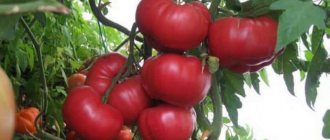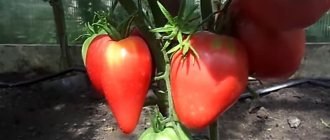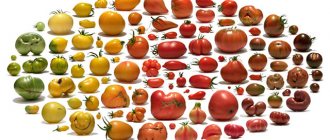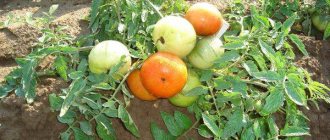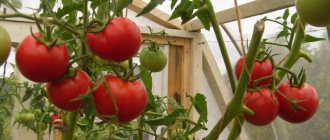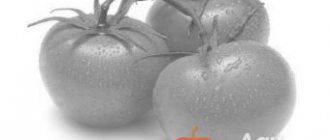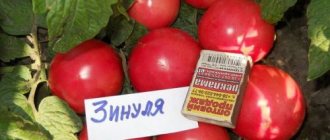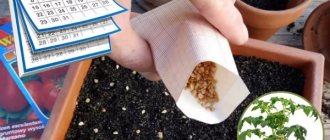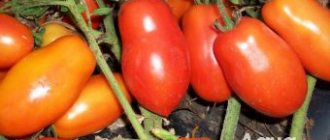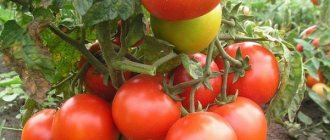» Vegetable growing » Tomatoes » Varietal characteristics of the Malinovka tomato
0
1028
Article rating
Pink tomatoes differ from other varieties in their specific but pleasant taste. One of the popular varieties is the Malinovka tomato. It was bred in Kazakhstan. If you want to be convinced of the ease of cultivation and good yield indicators of this variety, it is enough to plant these plants on your plot.
- Growing seedlings
- Preparing soil and containers
- Planting scheme
- Transplanting
- Deadlines
- Technology
- Care
- Watering
- Fertilizers
- Bush formation
- Disease and pest control
- Reviews from gardeners
Varietal characteristics of tomato Malinovka
Description of the variety
Russian breeders have been breeding this variety for several years. Having appeared in 2007, it has not yet lost its popularity. The variety is classified as mid-season. It tolerates prolonged drought well.
Characteristics of Malinovka tomatoes:
- Bushes planted in open ground grow up to 0.6 m.
- In a greenhouse they can grow up to 1 m.
- The foliage is dark green in color.
- The fruits of the Robin are round in shape with a ribbed surface. Ripe tomatoes have a raspberry color.
- This variety does not have many seeds.
- The tomato pulp is quite fleshy.
- One fruit weighs about 0.3 kg. The largest tomatoes weigh up to 0.6 kg.
With proper care, Malinovka gives a good harvest. From 1 sq. m. about 7 kg of fruits are collected.
They are used for fresh consumption, making salads, sauces, purees and juices. These tomatoes can also be canned whole.
In the southern regions of Russia, the variety is planted in open ground. In other regions it grows well in greenhouses.
Malinovka tomatoes, video
To obtain the most delicious and aromatic fruits of any variety, you need loose, humus-rich soil, moderate watering, maximum sun and an optimal number of healthy leaves.
You can see the best tomatoes for greenhouses with photos and reviews from gardeners from different regions in our selection of the most productive tomato varieties for greenhouses. Enjoy watching!
If you grew Malinovka tomatoes, please write what the yield and taste of the fruit was like in your climatic conditions. How do you rate the disease resistance of this variety? Briefly describe the advantages and disadvantages of this tomato in your opinion. If possible, attach a photo of your tomatoes to your comment. Thank you!
Your reviews of the Malinovka tomato, its pros and cons described, will help many gardeners evaluate this variety more objectively and decide whether it is worth planting or not.
This is a natural variety of tomato. Therefore, we recommend taking seeds from a ripe fruit and using them for planting in subsequent seasons.
Landing
Before sowing, it is necessary to prepare the seeds. To do this, they are soaked in a solution prepared from 1 g of potassium permanganate and 1 liter of water for at least 10-15 minutes. During this time, empty seeds will float to the top, and good ones will settle to the bottom.
Growing seedlings
Prepared seeds are sown in containers, pots or plastic cups. The soil for them can be purchased at the store or prepared yourself. In the second case, you will need to mix the same amount:
- garden soil;
- humus;
- wood ash;
- sand.
The seeds are placed at a depth of 1 cm and sprinkled with peat. The soil is moistened using a spray bottle. After this, the containers should be covered with polyethylene and placed in a warm, dark place. After the sprouts appear, the polyethylene is removed and the containers are placed on the windowsill. Exposure to sunlight will have a beneficial effect on the growth of seedlings.
Plants dive after they have 2 true leaves. This happens in about 15-20 days. The first couple of days after picking, you should not expose the seedlings to direct sunlight.
Characteristics of ripe fruits
The fruits of the Malinovka tomato, a photo of which is in the article, are very large. On average, the weight varies from 250 to 500 grams - a very good indicator. However, not all summer residents like this, but more on that later.
The taste is excellent - acid and sugar are well balanced, the pulp is very tender, as is the tomato aroma. The fruits are fleshy, with a small number of seeds. Thick skin and a small amount of water make it easy to transport them over long distances - tomatoes do not burst and do not give juice. For many summer residents who grow tomatoes for sale, the possibility of transportation is a very important indicator.
In addition, the thick skin ensures long-term storage - another important advantage.
Due to their large size, they are not the best option for pickling - they either will not fit in a jar, or they cannot be placed tightly together. But tomatoes are perfect for fresh consumption due to their excellent taste. The fruits are also a good choice for making ketchup, tomato juice and many other preparations.
Color at ripeness: The Malinovka plant has delicate pink skin. Standard weight: weight varies from 250 to 500 g. Shape: heart-shaped ball, large fruits. Culinary criteria: the taste is suitable for eating raw tomatoes, dietary salads, and preparing sauces.
The fleshy filling of the harvest, collected from the thin branches of a spreading bush, is distinguished by its noticeable sweetness. The dense raspberry skin protects the juicy content and seeds in small quantities.
For the first time, many are surprised by the results of planting; the fluffy bush brings up to 5 kg of fleshy berries. The fruits of the sweet variety of tomatoes differ from other subspecies in the following characteristics of a ripened tomato:
- Color at ripeness: The Malinovka plant has delicate pink skin.
- Standard weight: weight varies from 250 to 500 g.
- Shape: heart-shaped ball, large fruits.
- Culinary criteria: the taste is suitable for eating raw tomatoes, dietary salads, and preparing sauces.
The fleshy filling of the harvest, collected from the thin branches of a spreading bush, is distinguished by its noticeable sweetness. The dense raspberry skin protects the juicy content and seeds in small quantities.
Landing in the ground
Shortly before planting seedlings in the soil, you should begin to harden it. On the first day, it is recommended to leave the seedlings outside for 3 hours. In the second time the time is increased to 5 hours. On the third day, the seedlings are taken out for 8 hours.
Malinovka tomatoes should be planted in well-lit areas. The soil should have low acidity. Planting in the ground, depending on the region, is carried out in May - early June.
The area for planting is marked and holes about 20 cm deep are made on it. It is recommended to leave a distance between rows of 0.5 m and 0.4 m between bushes. Ideally per 1 sq. m. of soil, 4 bushes should be planted.
50-100 g of wood ash and 0.3 kg of humus are poured into the holes. After this, pour in 2 liters of warm water. Plant the seedlings as soon as the moisture is completely absorbed. The holes are filled with soil and watered with warm water.
Diseases and pests, ways to combat a possible problem
The powerful immunity possessed by the Malinovka tomato variety allows summer residents not to worry about the presence of tobacco mosaic and rot in their “country favorite.” Inexperienced gardeners should know that:
Fungicidal preparations protect resistant stems from the killing wave of fungal diseases. Preventive treatment of bushes with chemical mixtures of insecticidal drugs helps prevent attacks by parasites.
Care should be taken when using drugs; many drugs are dangerous for humans and pets. Tomato Malinovka is a wonderful tasty variety that will delight both greenhouse owners and those who have a personal plot
It produces spectacular, large and juicy fruits, indispensable for salads and juices
The Malinovka tomato is a wonderful, tasty variety that will delight both greenhouse owners and those who have a personal plot. It produces spectacular, large and juicy fruits, indispensable for salads and juices.
| Height | Landing location | Ripening time | Fruit color | Fruit size | Origin | Fruit shape |
| Medium height | Greenhouse, Open ground | Mid-season | Pink | Large | Variety | Flat-round |
Care
To get a good harvest, proper care of tomatoes is necessary. It is recommended to use exclusively warm water for irrigation. Young bushes are watered 1-2 liters at a time. Grown and mature plants need more moisture. At least 5 liters of water are poured under each bush.
Before the bushes bloom, the soil is fertilized. To prepare a solution for 10 liters of water, take 0.2 kg of humus and 0.3 kg of wood ash. 3 liters of mixture are poured under each bush.
Approximately 7 days before the start of fruit formation, fertilize with 0.4 g of ammonium nitrate dissolved in 5 liters of water. A week after the end of fruit formation, 30 g of superphosphate dissolved in 5 liters of water is added to each bush.
Be sure to remove the lower leaves. There should be no more than two stems. In this case, the nutrients will go not to increase the green mass, but to the growth of fruits.
The Malinovka tomato is resistant to pests and diseases. To prevent them, spray with a solution of copper sulfate or Confidor. When pests appear, fungicides are used.
Details about pink tomato
Malinovka was bred in the very cozy and small Kazakh city of Semey. This is probably why this tomato loves warmth and sun so much. In the southern regions of Moldova, Belarus, Ukraine and Russia, as well as in Kazakhstan, tomatoes are grown in open ground. Where the soil does not warm up even in summer, Malinovka can only be planted in greenhouses - the yield of the variety only increases with this method of cultivation.
The characteristics of the Malinovka variety are as follows:
- tomato is a semi-determinate type - in a greenhouse the bushes grow up to 120-150 cm, and in open ground the plants are not so tall - only 60-90 cm;
- tomato bushes are not too densely leafy, they are not standard;
- plants need to be shaped during growth;
- leaves of tomato type, medium size, green;
- the stems are very powerful, strong, thick;
- shoots are thin but strong;
- inflorescences are simple;
- The ripening period for Malinovka is average - the growing season ranges from 105 to 120 days (depending on growing conditions);
- the shape of the fruit is spherical, slightly ribbed;
- tomatoes are large, their average weight is from 250 to 500 grams;
- unripe tomatoes are colored light green; as they ripen, the fruits turn crimson-red;
- The peel of tomatoes is thick and durable, the fruits rarely crack;
- the pulp is very fleshy, there are few seeds in the tomatoes;
- the dry matter content is average, so the crop tolerates transportation well and can be stored for some time;
- Malinovka has excellent taste - balanced sugar and acid content, pronounced tomato aroma, tender pulp;
- The variety's yield is high - with proper care, it is possible to harvest more than five kilograms of tomatoes from every square meter of land;
- the Malinovka tomato variety is resistant to many bacterial and fungal diseases, including tobacco mosaic virus and blossom end rot;
- The Malinovka tomato harvest ripens very quickly, so you need to pick the tomatoes quickly, otherwise they will be overripe;
- The purpose of tomatoes is universal - they can be eaten fresh, used for making juices and purees, tomato paste, fresh vitamin salads;
- Growing Malinovka is possible both in protected and open ground.
Attention! Malinovka is a varietal tomato that has no hybrid forms or analogues. Therefore, the seeds of these tomatoes can be collected from your own harvest.
Advantages and disadvantages
The description of the variety will be even more complete if all the advantages of the Malinovka tomato are listed. And this tomato has a lot of advantages over other pink-fruited varieties:
- high productivity;
- unpretentiousness and resistance to dangerous diseases;
- large, even fruits that are not prone to cracking;
- high taste and commercial qualities of tomatoes;
- friendly ripening of tomatoes;
- suitability of the Malinovka for transportation and storage;
- non-hybrid origin of the variety.
The Malinovka tomato has no disadvantages as such. With proper care, you can harvest these delicious tomatoes from the last days of July until mid-September.
Important! Like all large-fruited tomatoes, Malinovka needs good nutrition and sufficient moisture. This is interesting: Beef-type tomato Russian Bogatyr - yield, description, reviews
This is interesting: Beef-type tomato Russian Bogatyr - yield, description, reviews
Clear advantages of the Kazakh variety
The pink giants of the Malinovka tomato variety, the apple essence of which is manifested in a similar shade and size, have a number of advantages that distinguish the tomato plant from other inhabitants of the garden beds:
- unpretentiousness of the plant in care;
- resistance of bushes during weather disasters;
- gastronomic versatility of fruits;
- Tomato resistance to cracking.
Fluffy bushes need regular watering with warm water, mineral fertilizer, and frequent weeding. It is advisable to water tomato bushes with warm water; among fertilizers, complex mixtures are successfully used.
